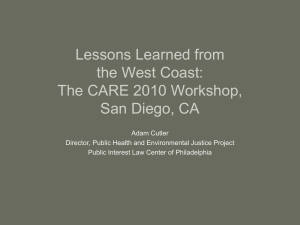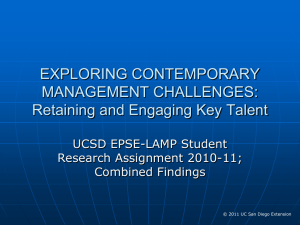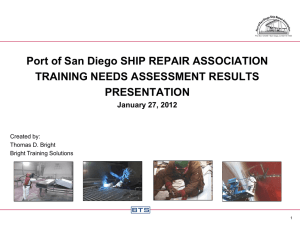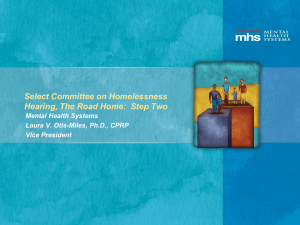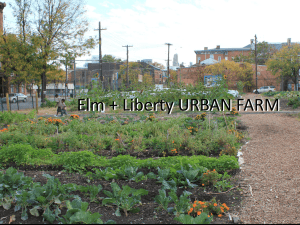Keith Corry, San Diego Housing Commission
advertisement
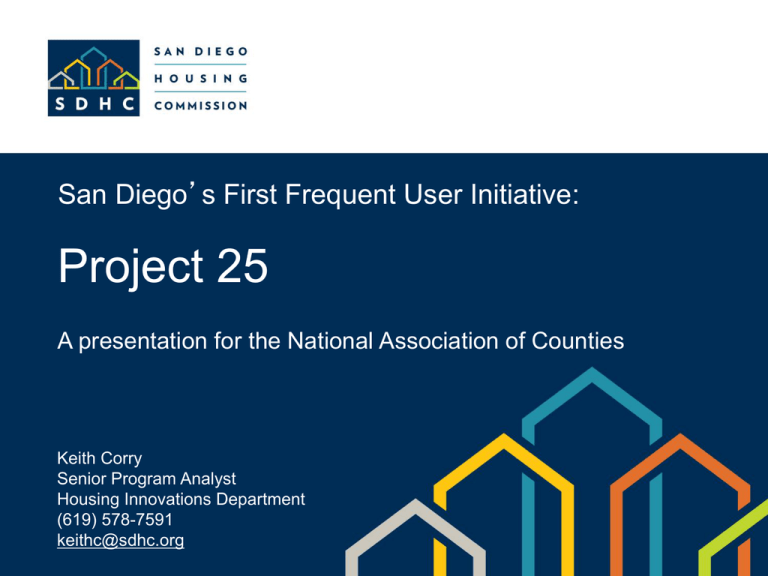
San Diego’s First Frequent User Initiative: Project 25 A presentation for the National Association of Counties Keith Corry Senior Program Analyst Housing Innovations Department (619) 578-7591 keithc@sdhc.org Project 25 is a 3-year frequent user initiative designed to: •Identify at least 25 of San Diego’s chronically homeless individuals who are among the most frequent users of public resources. •Provide them with long-term housing and supportive services using a scattered site Housing First model. •Follow participants’ progress as they improve in areas of mental and physical health, housing stability and substance dependence. •Measure participants’ financial and service level impacts to the community’s system of care by comparing pre-enrollment usage of public resources to their usage once enrolled in the program. San Diego Housing Commission Slide # 2 The Partnerships 1) The program is led by “Home Again,” a public engagement campaign of United Way to involve the community in ending homelessness in San Diego County. www.homeagain.com 2) A local homeless rehabilitation agency called St. Vincent de Paul Village provides administration and oversight of the program, intensive case management, full-scope coordination of care and data collection. www.svdpv.org 1) The San Diego Housing Commission provides and administers the long-term housing resources at scattered sites for the identified program participants. www.sdhc.org 1) The County of San Diego through its Housing & Community Development Department funds additional housing subsidies, and its Health and Human Services Agency leverages state funds identified for individuals with diagnosed mental illness for supportive services. www.sdcounty.ca.gov San Diego Housing Commission Slide # 3 Project 25 Frequent User Population • Because the program tracks utilization of public resources, the following providers were asked to submit separate lists of their top 25-50 frequent homeless users: 1) 2) 3) 4) 5) City of San Diego Emergency Medical Services (EMS) University of California at San Diego (UCSD) Medical Center Scripps Mercy Hospital San Diego County Behavioral Health Services San Diego County Sheriff’s Department • The data included the costs for emergency room visits, ambulance trips, inpatient medical and psychiatric hospitalizations, arrests, days in jail, Psychiatric Emergency Response Team (PERT) visits and crisis house days. San Diego Housing Commission Slide # 4 Methodology • Using the high user lists, a master list of 71 individuals identified as the most frequent users of services who were homeless in 2010 was compiled as the eligible Project 25 pool. • This comprehensive list was then re-distributed back to the providers. After all five entities re-ran the comprehensive list, cross system matches surfaced, showing those who frequently accessed multiple services. • Names of individuals who accessed at least two of the target services were collected and then ranked using an estimated cost per unit of service for the following: 1) 2) 3) 4) 5) 6) 7) San Diego Housing Commission Slide # 5 Emergency room visit Ambulance ride Day of in-patient hospitalization Arrest Day in jail PERT visit Crisis house day Methodology • The five organizations that originally provided individual high user lists signed MOU’s with Project 25 for the release of names and frequency of use data. • During the cross system checks, many users were placed on provider lists because of costly treatments of isolated, but medically complicated or acute conditions. • These individuals were not used in the Project 25 participant selection because their use of the systems did not occur repeatedly. • This is a good example of why tracking user costs should be only one of several variables used in participant selection. Also, because the initiative targeted high homeless users, stably housed frequent users were not selected for participation. San Diego Housing Commission Slide # 6 Methodology • Once participants were identified, screened for eligibility and interest, and then offered enrollment into the program, the data matches were expanded to include many other providers that the participant may have used (see next slide). • Participant names were shared with more ER’s, ambulance companies, psychiatric in-patient hospitals, detox facilities, homeless shelters and jails within the county. • Using this expanded list of data partners to cross-reference participants, the following indicators were established and assigned a monetary value for purposes of quantifying public resource use: • • • • County psychiatric hospital services Arrests Jail days Public Defender/court costs San Diego Housing Commission Slide # 7 • • • • Crisis house days PERT visits Homeless shelter days Detox/sobering center days Project 25 Data Partnerships The number of partners who have participated in the contribution of data for our target population has grown significantly since the program launched. Our current data partners include: Hospitals: Ambulance Providers: •Alvarado Hospital •Scripps La Jolla Hospital •Alvarado Parkway Institute •Scripps Mercy Hospital •Bayview Hospital •SHARP Chula Visa Hospital •Kaiser Foundation Hospital •SHARP Coronado Hospital Other Providers: •Palomar Medical Center •SHARP Grossmont Hospital •Paradise Valley Hospital •SHARP Memorial Hospital •Pomerado Hospital •SHARP Mesa Vista Hospital •County Alcohol and Drugs Services •County Behavioral Health Services •San Diego County Public Defender’s Office •San Diego County Sheriff’s Department •Promise Hospital •Tri-City Medical Center •Scripps Chula Vista Hospital •UCSD Medical Center •Scripps Encinitas Hospital •VA Medical Center San Diego Housing Commission Slide # 8 •Emergency Medical Services (EMS) •American Medical Response (AMR) •Heartland Fire and Rescue Shelters: •Rachel’s Women’s Center •Salvation Army •San Diego Rescue Mission •St. Vincent de Paul Village •Veterans Village of San Diego Project 25 Successes/Challenges • Overcoming data sharing concerns was a significant challenge at the start of the program. • To address the concerns, all Project 25 partners are included in an MOA to share only the information that aids in identifying the frequent users. No protected health information is shared among the partners. • Hospitals and other services are beginning to realize that this gap in care cannot be thoroughly addressed unless we follow the cases of those who are returning back into the same programs and services. • Another issue was how to locate, identify and keep users housed once enrolled in the program. Due to the vulnerable and transient nature of this population, this continues to be a challenge. However, the data sharing partnerships have helped develop a network for communicating and working together to provide a more comprehensive and efficient continuum of care. San Diego Housing Commission Slide # 9 Project 25 Successes/Challenges • Convincing potential partnering data sources to track high users separately from their normal service delivery methods was difficult given how busy and chaotic these environments can be. • Now realizing the value in collecting data on this population, a flagging system was implemented at ERs and jails so when an identified frequent user was found, Project 25 was immediately contacted for coordination of care. • Finding willing landlords and property owners for this population proved difficult at first. San Diego Housing Commission’s relationships with affordable housing providers and property owners around town helped with this effort. • This group has very specific and intensive service needs. San Diego Housing Commission Slide # 10 Project 25 Preliminary Outcomes One year into the program, results from the combination of long-term housing and supportive services are dramatic: •Total cost of public resources for project participants fell to $3.4 million in 2011 from more than $11 million in 2010. •Per person average was $97,437 in 2011, down from $317,904 in 2010. •Emergency room visits down 77 percent. •Ambulance transports down 72 percent. •In-patient medical stays down 73 percent. •Arrests down 69 percent. •Jail days down 43 percent. San Diego Housing Commission Slide # 11 Project 25 Take-Aways • Like other leading high user studies, the outcomes of Project 25 appear to indicate a dramatic reduction in all monitored public service usage, as well as significant cost savings. • We acknowledge critics who dispute the claim that high user programs result in cost savings since ERs will always be busy, and jails will always be full. However, Project 25 has already shown an ability to expand service delivery capacity by relieving the heavy use of services by a relatively small population. • In a time of constantly diminishing resources, we believe Project 25 proves that more compassionate and precise targeting of high volume users will result in more efficient and effective help for the chronically homeless population. San Diego Housing Commission Slide # 12

